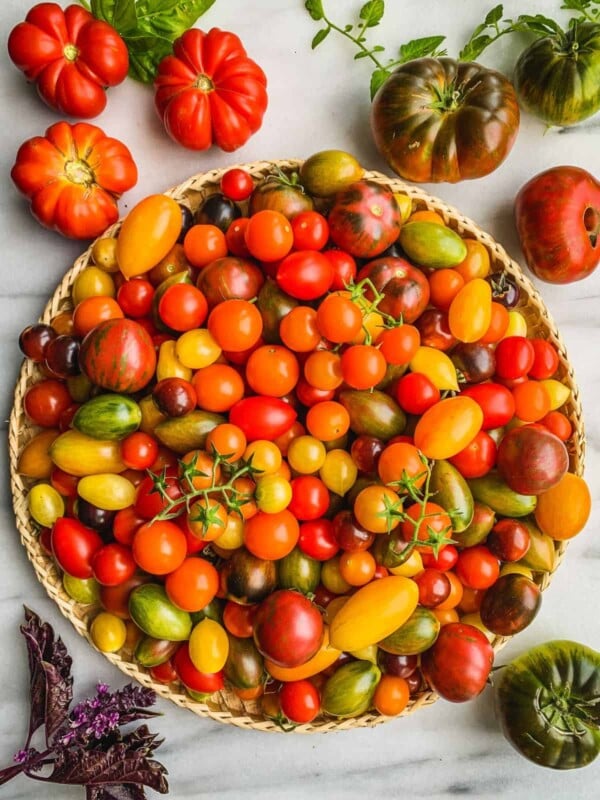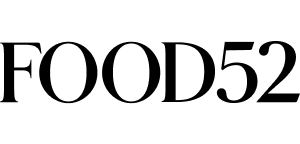Basil (Ocimum basilicum) might just be one of the world’s most popular herbs. It is a species in the Lamiaceae family that includes many of our favorite culinary herbs like mint, rosemary, savory, marjoram, sage, oregano, hyssop (za’atar), thyme and lavender.
The family also includes medicinal herbs such as bee balm, salvia and catnip. This post covers everything you need to know about this timeless herb including different varieties, culinary uses, growing, storing, preserving, substitutions and recipes.

Table of Contents
History
Basil is native to tropical regions like Central Africa and Southeast Asia, though it is now cultivated worldwide. There are cultural and historic rituals and beliefs associated with basil. Ancient Egyptians and Greeks believed that basil opens the gates of heaven in death.
Culinary uses
No doubt, basil is synonymous with Genovese pesto. However, depending on the variety, basil leaves can be added to stews, salads, curries and even cocktails. My book, Seed to Table, features a Basil Smash cocktail recipe that uses Thai basil.
Basil seeds are edible and are typically consumed after having been soaked in water. There are commercial basil seed drinks available on the market. As the seeds soak, they become quite gelatinous.
They are used in drinks and desserts throughout Asia. Sharbet-e-rihab is a popular Persian drink. Fun fact, the word “rihan” is the Farsi and Arabic word for basil. Basil seeds also feature in Falooda, a refreshing summer treat from India.
Basil Varieties
Genovese Basil: A classic Italian sweet basil variety perfect for Walnut Pesto, Sicilian pesto, salads, bruschetta, and bruschetta pizza. The leaves are dark green and the leaves can get quite large (up to 3” in length). For me, this is an excellent variety to grow in the home garden or hydroponically indoors.
Thai Basil: This variety includes several cultivars including Sweet Thai and Cinnamon basil. They have a distinctive aroma and taste that is almost spicy or reminiscent of licorice. Their flowers are strikingly beautiful, forming purple clusters. Thai basil is used in a range of Southeast Asian dishes such as Thai curries, soups and salads.
Lettuce Leaf basil: As the name suggests, the leaves of this variety are lettuce-like. They are large and can reach the size of your palm. They are milder in flavor but can still be used to make pesto or thinly sliced (chiffonade) and added to burrata bruschetta, crostini, soups and salads.

Purple Basil: Strikingly beautiful, purple basil adds a pop of color to any dish. I recommend only consuming purple basil in fresh applications like salads. The color will change if subjected to heat.
Lemon Basil: As the name suggests, this basil has a lemony, citrusy aroma. It can be used when your recipe calls for a citrus note. Use it in desserts or steep it for tea.
Greek (Globe) Basil: This variety is perfect for containers and small spaces. The plants grow in the shape of a globe, with small aromatic light green leaves.
Holy Basil (Tulsi): Incredibly important and highly revered variety that is indigenous to the Indian subcontinent and has been used in Ayurvedic medicine for thousands of years.
As the popularity of basil grows, plant breeders are releasing new hybrid seed varieties with new and exciting aroma and flavor profiles, as well as improved disease resistance. If you love to experiment in the kitchen, I highly recommend growing unique varieties that are difficult to find at the grocery store.

Other uses
Basil is used in Ayurveda or traditional Chinese medicine.
High-level nutritional information
Basil is a source of many minerals and vitamins including calcium, iron, magnesium, manganese, vitamin A, vitamin C, vitamin K and folate. As always, for specific nutritional information or for dietary advice, please consult a licensed dietician or nutritional specialist.
How to grow
Basil is typically treated as an annual (a plant that will grow for one season). Basil can be grown from seed (which you can start indoors or in a greenhouse 6-8 weeks before you plan to transplant outside) or it can be grown from seedlings.
When starting from seed indoors, it is best to use a well-draining quality seed starting mix. A heat mat can be used to speed up germination and grow lights should be used to avoid leggy seedlings. My book, Seed to Table, includes seed starting tips and advice as well as an exclusive seed starting video.
Garden centers and nurseries will carry several varieties of seedlings in the spring. There is no shortage of supply as basil might just be one of the most popular herbs to grow.

Basil thrives in full sun and does not like cold and wet conditions. I would wait until overnight temperatures are at or above 10°C/50°F before transplanting basil seedlings outside. They should be planted in an area that gets full sun (at least 6 hours of direct sun a day).
One of the challenges of growing basil is that it tends to flower quickly. When it begins to flower, it is important to cut it back so that the plants can continue to grow delicious leaves. If the plants are allowed to flower and go to seed, the leaf production will halt and the plant will focus its energy on reproduction (seed formation).
The best way to harvest is by snipping right above a leaf node. This allows the plants to bush out by sending out two few branches. See the image below.

As you can see, there are two new stems growing from that node. These stems will continue to grow and produce more side shoots as they are pruned back, resulting in bushier plants.
Succession plant: One way to ensure an ample supply of basil all season long is to stagger your planting so that you can continuously harvest. Start seeds at regular intervals or take cuttings from an established plant and root the cuttings to clone the plant.
I personally grow it in the ground, in raised beds, and in containers. You can also grow it hydroponically.
If you planted basil in a well-amended bed or container, it shouldn’t need to be fertilized often. If you do choose to fertilize it, use an organic formulation with a higher proportion of nitrogen (which encourages the growth of foliage).
Favorite Varieties to grow and use
There are so many amazing varieties to choose from. My favorites include Genovese, Prospera, Dark Opal, Purple Ruffles, Cinnamon, and Lettuce Leaf.
A note on garden center seedling labels. Oftentimes, plants will be labeled with a generic name (for example, “purple basil”) rather than the actual variety name. The true variety name is only important if you’re planning to start seeds yourself. So don’t fret.
When shopping for seedlings at the garden center, simply rub the leaves between your fingers and give them a smell. If the smell is pleasing, go ahead and purchase the seedlings. Trust your senses and don’t worry about the labels.

Culinary Substitutions
In my opinion, there is no substitution for aromatic and delicious basil. However, in a pinch, you can certainly substitute it.
- Parsley is a great substitute. It is mild and not too overpowering. It can be used in recipes that feature basil like my Burrata Bruschetta, Goat Cheese Bruschetta and Burrata Caprese.
- Cilantro can be used as a substitute however it is important to note that the flavor profile will be altered, especially if using large quantities. It is best to use cilantro as a substitute only as a garnish. I personally love the flavor of cilantro, but there are many people out there who don’t (they claim it tastes like soap). In my opinion, cilantro is a great substitute for Thai basil in curries and soups.
- Mint can be used as a substitute for sweet basil. It’s important to taste and adjust the quantities as you see fit.
- Oregano is another possibility. The flavor of fresh oregano can be overpowering so you’ll need to trust your gut and your taste buds and make the necessary adjustments.
It bears repeating, I would not recommend substituting basil unless you have an allergy to it.
How to store
If you’re growing basil in your garden or on your windowsill, I suggest only harvesting what you need for a given recipe. But if you need to harvest basil in large quantities or if you buy a bundle from the store, here are some storage options that will help keep it fresh the longest.
- Treat it like you would fresh flowers. Place stems upright in a mason jar with water. Basil placed in water this way can last for a few days on the counter. For longer-term storage, place the jar in the refrigerator with a thin plastic bag loosely covering the basil. Change the water every few days. Basil may stay fresh for up to 14 days this way.
- If you purchase basil in a clamshell container, it is best not to mess with it too much. The leaves are tender. If the leaves bruise, they may oxidize and turn brown.

How to preserve
Basil can be preserved for long-term storage in several ways.
- Drying: This isn’t my preferred method, as I am not a fan of dried basil. However, if you do, you can certainly dehydrate it using a dehydrator.
- Compound butter: Freezing fresh chopped basil in butter is a wonderful way to preserve it. Use pats of compound butter on grilled vegetables, steaks, and more.
- Frozen cubes: Freezing cubes of basil in olive oil is a wonderful way to lock in its freshness for months to come. I like to use silicone ice cube trays filled to the brim with freshly chopped basil and covered with olive oil. Once frozen, I transfer the frozen cubes to a reusable freezer bag. The cubes can be used to make pesto, swirl into soups, and added to marinades all winter long.
- Pesto: My favorite way to preserve basil. Pesto can be frozen for long-term storage and used whenever you need to whip up a quick meal.
Check out this parsley preservation blog post for more information. Some of the preservation techniques listed are applicable to basil as well.
Recipes
Check out some of these recipes on my blog that feature basil: Walnut Pesto, Bruschetta Pizza, Sicilian Pesto, Garlic Scape Pesto, and Roasted Tomato Sauce.
Check out more recipes on the blog:
If you have any questions, please take a moment to leave a comment below. It’s such a help to others who want to try the recipe. For more Urban Farm and Kitchen, follow along on Instagram, Facebook, and Pinterest, visit the Urban Farm Shop, or subscribe for new posts via email.
















